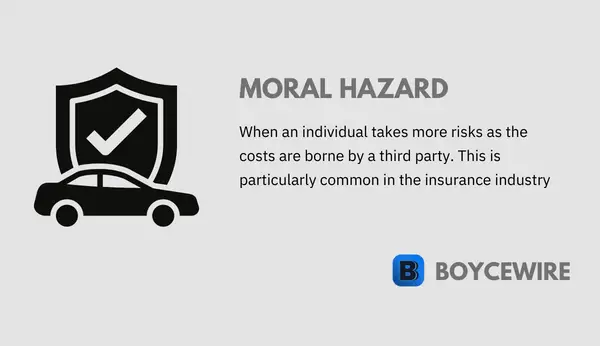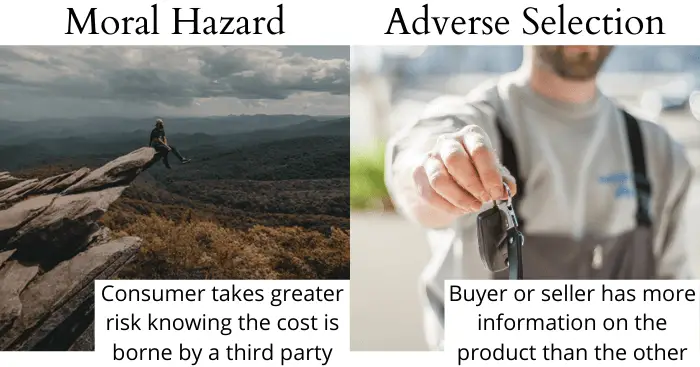Moral Hazard: Definition & Examples

What is Moral Hazard
A Moral Hazard is where an individual becomes reckless because they know another party will pay for the effects of their actions. In other words, it is when a person does not consider or care about the cost they are imposing on someone else, so take greater risks. For example, a consumer with insurance may take more risk because they do not have to pay the cost if something goes wrong.
The term ‘Moral Hazard’ originates from insurance companies back in the 17th Century. Its original use had little to do with morals and ethics. Instead, it related to the inefficiencies that occur as the risk and cost is borne by a third party.
Key Points
- A moral hazard is where the consumer takes more risks as the costs are paid for by a third party.
- Moral hazard differs from adverse selection in the fact that there is a misalignment of information after the transaction is placed – whereas adverse selection is where there is a misalignment of information before the transaction.
- A moral hazard is a problem because it creates an inefficient allocation of resources as people take unnecessary risks, so therefore create unnecessary costs.
Moral Hazard Examples
Moral Hazard Insurance
One example of moral hazard is where consumers of car insurance may in fact take greater risks once they have cover. For instance, they may leave their vehicle parked in an unsafe place overnight. Or, they may drive a bit too fast, meaning the risk of an accident is higher.

These are moral hazards as the consumer takes more risks because they are insured. And they do so because the incentive to reduce the risk is also reduced as a third party pays for the consequences.
Elsewhere, gadget insurance is notably expensive. Often it makes no sense to purchase insurance because you could buy another for a year’s worth of cover. However, it is so expensive because of those who take it out cause a moral hazard. This may be leaving a laptop unattended at the library, or not taking due care with their phone as they text whilst walking.
Moral Hazard in Banking
The 2008 financial crisis can be seen as a moral hazard. As leading financial institutions such as Fannie Mae and Freddie Mac took big risks with sub-prime mortgages, they were to eventually be bailed out by the government.
The bailouts represented a moral hazard because it sent a message to the big financial institutions that they were ‘too big to fail’. Once they were saved, the message was that they can take excessive risks in the knowledge that the cost would be borne by the taxpayer.
As a result, there is a chance that financial institutions will continue to take excessive risks in the knowledge that they will always be saved.
Why is Moral Hazard a problem?
Moral hazard presents an economic problem because it creates an inefficient allocation of resources, as one party creates a greater cost on a third party than they would otherwise.
It is important to note that moral hazard does not necessarily mean consumers are speeding at 100mph because their car is insured. Instead, it means that some consumers are likely to take so much care. For instance, a driver may leave their car parked in an unsafe location overnight.

Now, this may only slightly increase the risk of it being stolen or damaged. However, it is a risk that the insured party takes in the safe knowledge that they do not have to pay for the consequences.
On a micro basis, the economic effect is minuscule. Yet this is contrasted on a macro level. For instance, if 325 million US citizens all increase their level of risk, by the law of probability, the external cost will be massive.
How to Reduce Moral Hazard
At the heart of moral hazard is a misalignment of incentives. One party has an incentive to minimize the costs and risks, whilst the other doesn’t. In insurance, for instance, the insurer wants to ensure costs are low and its consumers do not take unnecessary risks. However, by obtaining insurance, a moral hazard is created, because the consumer may not be as careful as they would otherwise.
One solution provided in the insurance industry is the ‘no-claims bonus’. For those customers who do not make a claim, their premiums gradually decline. So customers are actively encouraged to not make a claim. Therefore, any unnecessary risks taken by the customer will cost them in terms of higher premiums in subsequent years. In turn, the risk is partially shared by both the insurer and the consumer.

In addition, insurance providers include ‘excess’ in the policy. So for each claim the customer makes, a cost is also imposed. In a similar fashion, this also spreads the risk onto both parties, so should the customer increase the risks they take, they too will face the consequence.
In turn, this creates a positive incentive for the customer not to make a claim unless the claim is significant. This helps reduce the amounts of petty claims which are more common in low levels of insurance policies such as car and gadget insurance.
Some reckless drivers then take more risks than the average driver may be more prone to dent their car. What the excess does is protect the insurance company by discouraging the customer to make a claim.
First of all, they lose their no-claims bonus. Then second of all, they have to pay an excess than may equal the exact amount of the repair. In turn, it’s not worthwhile to make a claim.
In conclusion, the way to solve the issue is to ensure that both parties are liable. So should one party increase the level of risk they take, those costs will also be imposed onto them. In turn, this reduces their incentive to undertake risky activities.
Moral Hazard vs Adverse Selection
Moral hazard occurs when a consumer takes an additional risk in the knowledge that a third party will pay for the cost. So the additional cost is created AFTER the consumer purchases an insurance policy.
By contrast, adverse selection refers to a situation where the buyer and seller have different information BEFORE the transaction. So for instance, the consumer may know they are a heavy smoker and have problems breathing as a result. However, the insurance company may not know this information which creates adverse selection.

If we now compare to a moral hazard, it would occur once the insurance policy is purchased. So an individual takes a greater risk. They may start smoking five packets of cigarettes after they are covered. And even though this is unlikely, it goes to demonstrate the difference between the two.
In short, moral hazard refers to consumers taking more risks after taking out insurance. By contrast, adverse selection is where the buyer or seller has more information before a good is purchased.
FAQs
A moral hazard is where an individual takes a greater risk in the knowledge that the consequences will be paid for by a third party.
Moral hazard is a problem because it creates additional costs onto a third party as an individual takes greater risks which also poses greater costs.
A moral hazard can be resolved by trying to align the incentives of both parties. For instance, insurance firms include the excess in their policies in order to ensure that the customer also pays when they make a claim. So when a claim is made, the consumer also has a charge. In turn, this incentivises them to take more care.
About Paul
Paul Boyce is an economics editor with over 10 years experience in the industry. Currently working as a consultant within the financial services sector, Paul is the CEO and chief editor of BoyceWire. He has written publications for FEE, the Mises Institute, and many others.

Further Reading
 Purchasing Power Parity: Definition, Examples & Types - Purchasing Power Parity is a measurement that economists use to compare the spending power between two or more nations.
Purchasing Power Parity: Definition, Examples & Types - Purchasing Power Parity is a measurement that economists use to compare the spending power between two or more nations.  Earnings Per Share - Earnings per share (EPS) is a financial ratio that represents the portion of a company's profit allocated to each outstanding…
Earnings Per Share - Earnings per share (EPS) is a financial ratio that represents the portion of a company's profit allocated to each outstanding…  Eminent Domain - Eminent domain is the legal power of a government to expropriate private property for public use, accompanied by the requirement…
Eminent Domain - Eminent domain is the legal power of a government to expropriate private property for public use, accompanied by the requirement… 